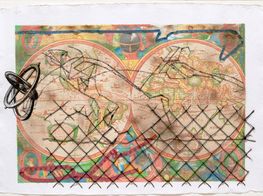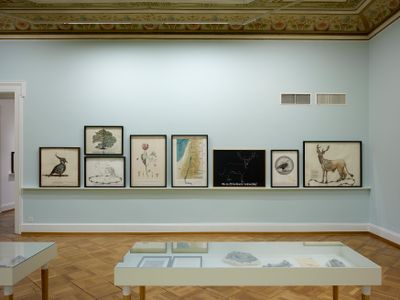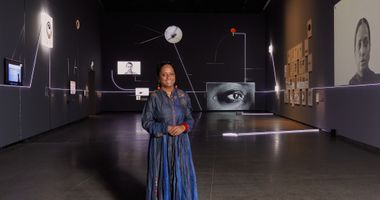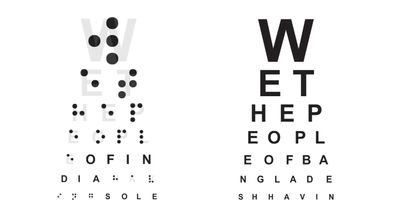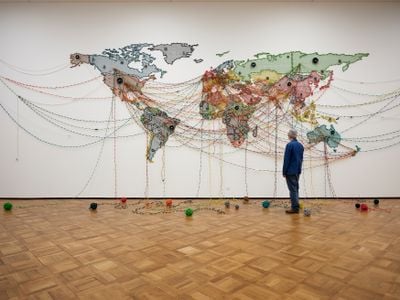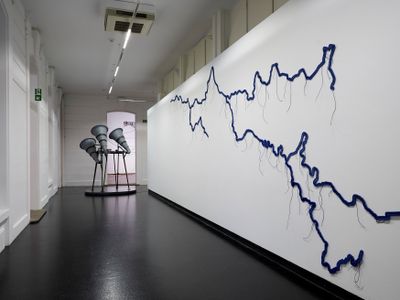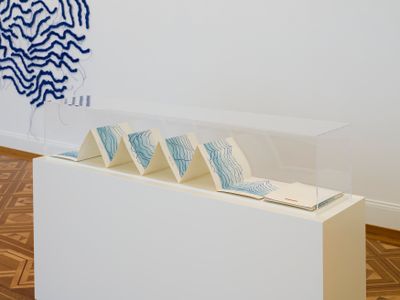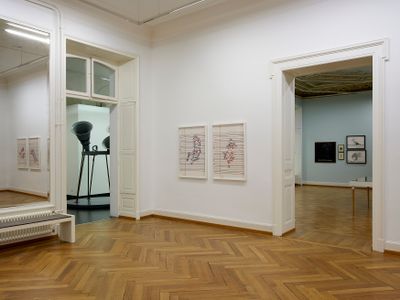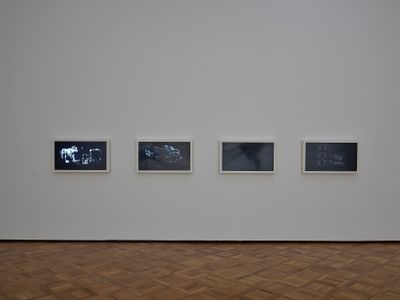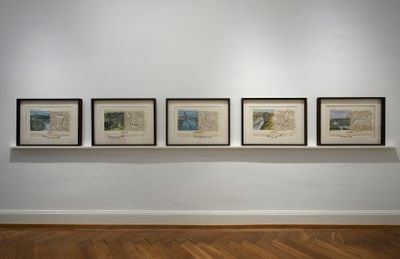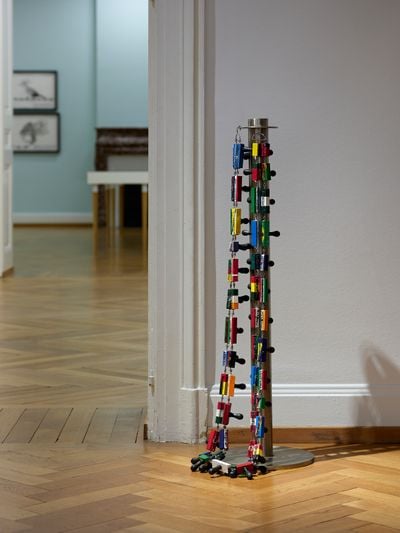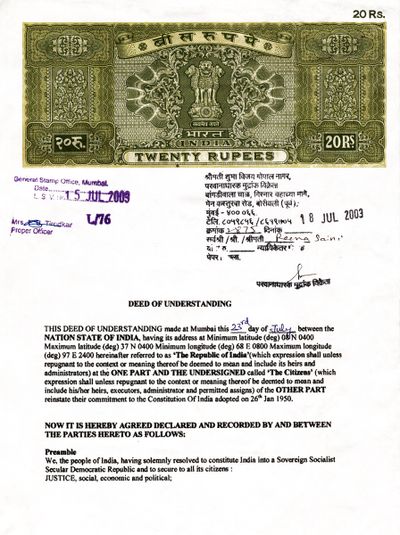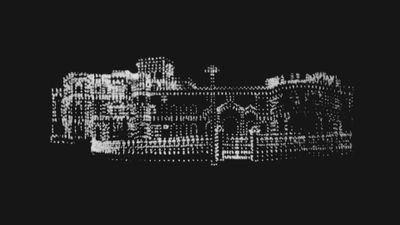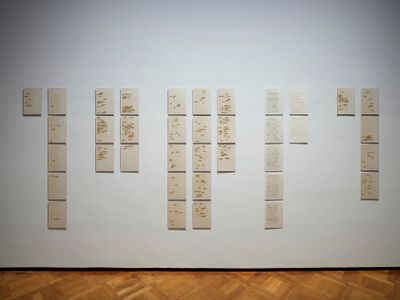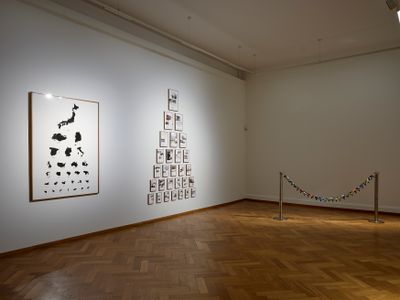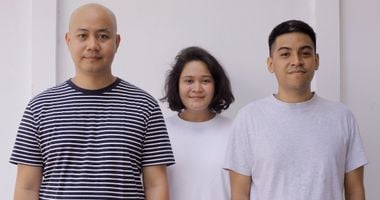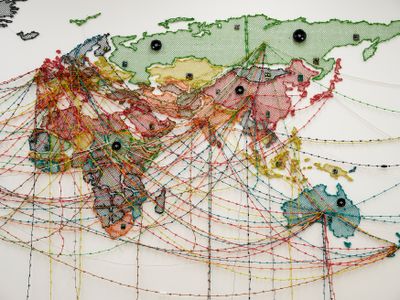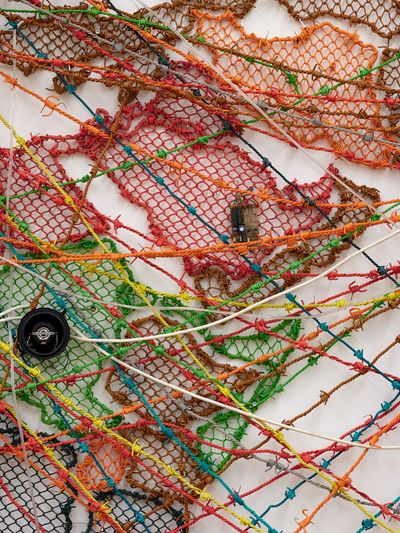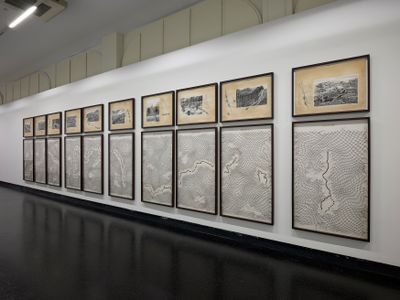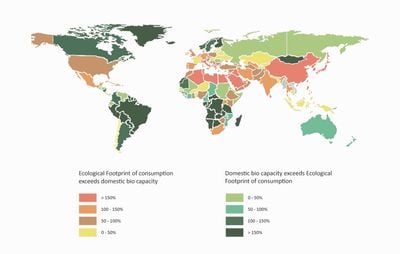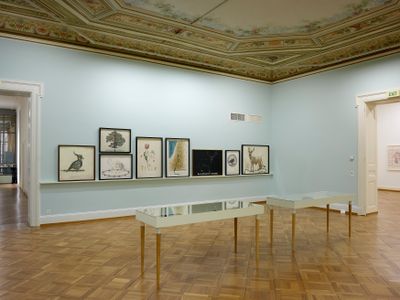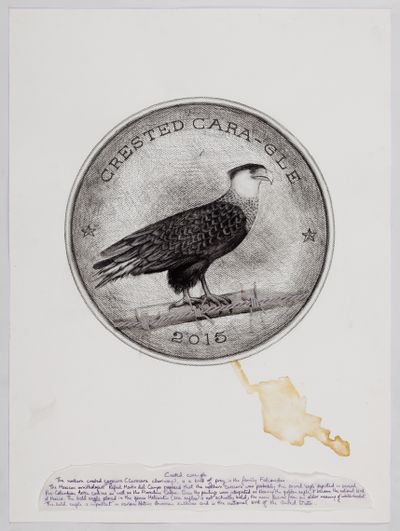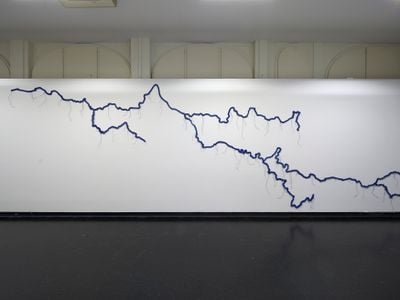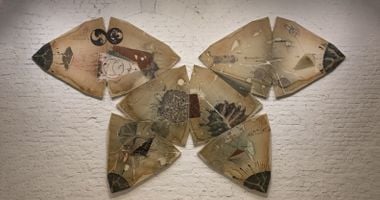Reena Saini Kallat's Complex Hybridity
Reena Saini Kallat. Photo: © David Aebi.
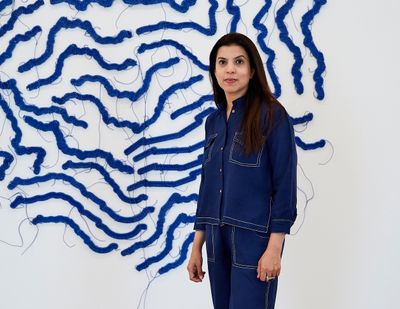
Reena Saini Kallat. Photo: © David Aebi.
Reena Saini Kallat is an artist who consistently challenges the divisions that define the world as a site of political and national separation, with works that illuminate the complex fluidities that shape planet Earth as an embodied site.
Deep Rivers Run Quiet, the artist's first solo museum show in Switzerland at Kunstmuseum Thun (10 June–3 September 2023) is a case in point. The exhibition takes its name from the artist's 20-part work on paper with the same title (2021–2022) where she repeatedly traced the lines defining international borders subsumed by conflict over the sharing of their rivers, turning them into waterscapes superimposed with fragments of paper on which the lines are stacked like contours.
To create each drawing, Kallat projected the borders of countries in conflict over their common river waters on panels and traced their outlines. That act of hand-driven mechanical transfer echoes the crude imposition of borders by colonial powers in the 20th century, whereby straight lines on a map were violently translated to earthen terrains.
The 2019 installation Leaking Lines, grounds those histories with ten panels that present the outlines of boundaries around the world rendered in grey electric wire and black thread, alongside annotated archival images of the landscapes they cut through.
Among the lines in focus is the Green Line between Israel and Palestine, named after the pencil that marked the map that once defined the boundary; and lines carving up the Indian subcontinent, named after the British officers who drew them, such as the Radcliffe Line.
The challenge that Kallat makes to the borders defining the globe as a site of ongoing capture and conflict is rooted in the material realities of the natural world. Take the sound sculpture series 'Chorus I' and 'Chorus II' (2015–2019), recently included in Sharjah Biennial 15, which consists of metal speakers whose designs are based on pre-radar listening devices used to locate enemy aircrafts during World War II.
Subverting their original function, Kallat plays recordings of birds singing together, each one associated with nations that share a hostile or historically conflictual border. Pairings include the English robin and Irish lapwing; Mexico's crested caracara and the American bald eagle; the Pakistani chukar and Afghani golden eagle; the Indian peacock and doyel of Bangladesh; and the giant ibis of Cambodia and Thai-associated Siamese fireback.
While these birds have been appropriated as national symbols, they inhabit both territories, as Kallat has pointed out: 'The interlaced chorus of freely drifting birds in "Chorus" alludes to nature's defiance of artificially imposed, man-made divisions.'
At Sharjah Biennial 15, 'Chorus' was installed on the ground floor of the Bank Street Building. The series was also featured in Common Ground, Kallat's largest show in the U.K. at Compton Verney (2022–2023), Warwickshire, alongside works like Verso-Recto-Recto-Verso (2017–2019).
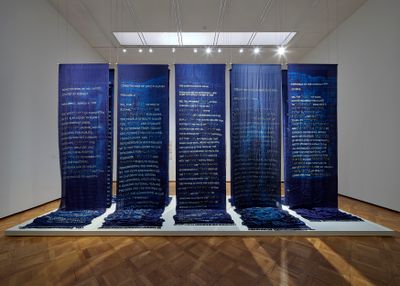
Ten indigo-dyed silk scrolls made using the tie-and-dye technique by artisans from Bhuj, a town in the Indian border state of Gujarat, cascaded from the ceiling. Each fabric presents preambles from constitutions of politically partitioned countries or nations in a state of conflict, among them North and South Korea, and Bangladesh and India, with repeating words identified in yellow embroidered braille.
In Kallat's video Blind Spots (2017–2019), all shared values common to the constitutions of countries on both sides feature as braille text to suggest the metaphor of losing sight of common aspirations.
Born in Delhi in 1973 and now based in Mumbai, Kallat has explored the Preamble to the Indian Constitution since 2003. The video Synapse (2010–2011) shows people trying to read it as letters of a Snellen chart, used by ophthalmologists to measure vision during eye tests. But Kallat's concerns are not limited to the context of the subcontinent, no matter how paradigmatic an example it is of the violence that can result from the imposition of arbitrary divisions.
In Woven Chronicle (2018–2023), a weave of electrical wires presents a world map with the south on top, intercut with a network of barbed wires, while Colour Curtain (between shores and the seas) (2009) strings colourful hand-painted rubber stamps of national flags, each recording the names of people denied visas.
More recently, the artist's museum show in Switzerland has been conceived in dialogue with the nearby river Aare. Kallat elaborates on this connection in the following conversation, which took place ahead of the artist's participation in the group shows Traces of Place at Chemould Prescott Road, Mumbai (13 July–19 August 2023), and Between Borders at Museum Arnhem, Netherlands (15 July–22 October 2023), plus the launch of Fluid Geographies, an outdoor project celebrating the 75th anniversary of Geoffrey Bawa's estate at Lunuganga, Bentota (20 July–30 November 2023).
SBYour first solo exhibition in Switzerland, Deep Rivers Run Quiet, features works that have been conceptualised in dialogue with the river Aare. Could you introduce this show and talk about how this dialogue with the river is expressed?
RSKOur connection to water lies both internally and externally. Not only is water the origin of all known forms of life but our very bodies are composed of it.
I began thinking more deeply about our relationship with rivers when I took part in The River Project at Campbelltown Arts Centre in Sydney in 2010. While rivers have been the lifeblood of civilisations, so much conflict between countries surrounds their use as a resource. Our dependence on them should encourage us to find ways to cooperate, but often the sharing of waters results in the partitioning of rivers.
Take the river Indus that flows through India and Pakistan; its tributaries, Ravi, Beas, and Sutlej flow into India—while the Jhelum, Chenab, and Indus flow into Pakistan. Despite having multiple names, its waters remain the same.
I'm interested in how rivers challenge maps and political treaties outlining control over their use. As arterial living bodies, they remind us of connections that run far deeper than national divisions. Kunstmuseum Thun is located along the river Aare, the longest Swiss river, and the Museum's director, Helen Hirsch, was keen on foregrounding works of mine that relate to the environment.
In shaping the exhibition, we decided to focus the first part of the show on works pertaining to rivers and their political impact on humans and territories. The river Aare is visible from the south-side windows of galleries and most visitors coming from the train station are likely to cross two bridges over it to reach the museum.
SBDeep Rivers Run Quiet shares a name with your 2020 series of works on paper that explores the line as the foundation of conflicts between nation-states, which connects to your other series, 'Leaking Lines'. Both projects constitute a historical study of line-making on a geopolitical level. How do you use the artistic trace to challenge the drawing of political lines?
RSKThe line is an integral part of an artist's tool kit as a formal device, yet when drawn across territories has huge implications for people living on either side of these constructed borders.
The key question in relation to cartography is not just how we shape maps, but how maps have shaped our understanding of the world.
'Leaking Lines' highlights the absurdity of often arbitrarily drawn borderlines and the histories of their making. The controversial Radcliffe Line drawn during the partition between India and Pakistan, or the McMahon Line between Tibet/China and Arunachal Pradesh in India, for example, were insensitively imposed by British colonial officers.
These partitions cut through communities on either side, such as the Pashtun population between Afghanistan and Pakistan, in the case of the Durand Line, without thinking of the people, hills, valleys, or rivers that flow across them.
Rivers don't recognise political demarcations as they chart shifting natural boundaries between land and water while nourishing states on either side. Their fluid nature defies rigid cartographies. In Deep Rivers Run Quiet, I'm looking at politically divided regions that are otherwise connected by rivers. These include landscapes across the Teesta, Arpacay, Rhine, Tagus, and Jordan rivers, among others.
SBYour work has explored both the impact of border-making on the Indian subcontinent and that of nation-building in India post-Independence, notably in Synapse, as well as Untitled (Enemy Properties) (2019), a four-channel video looking at the Indian government's takeover of Pakistani-owned property following the outbreak of the Indo-Pakistani War in 1965. Could you expand on how you read, interpret, and relate to the history of the Indian subcontinent post-Partition?
RSKThe Partition of India and Pakistan adversely impacted the lives of millions, including my paternal family and the legacy of this event continues to stimulate important questions around loss, displacement, and memory in my work.
It is not about harmonising but recognising complexity in hybridity, which challenges limiting notions of identity.
The consequences of Partition remain perceptible not just among those directly affected by it, but even in light of the two nations continuing to be in conflict despite the long-shared histories, cultures, and values.
I grew up in Mumbai (Bombay), the most cosmopolitan city in India, largely made up of migrant communities, and yet there's been a history of resistance towards outsiders within the city. In the early 2000s, several North Indian migrants encountered resentment from locals who viewed them as a threat.
Today, such insecurities are a global phenomenon. Some of these inquiries about exclusion and the resistance to pluralism began to interest me while thinking about social and psychological barriers. The strain between religious communities is the legacy of Partition and the unfinished colonial project, while electoral politics continue this divisiveness, engendering hate and fear among people.
I started working with the Preamble to the Constitution of India in 2003 in a sculptural work titled KIOSK, formed by hundreds of rubber stamps, the ubiquitous administrative apparatus. This was accompanied by a mock legal document, like an MOU (Memorandum of Understanding), with the names of people from all over the country stamped within the document, as if claiming their place in a democracy.
A reminder of our constitutional rights and responsibilities, going over the values and principles embedded within the constitution was a way to think of its relevance over time with changes in our democratic fabric.
In 2009 and 2010, I revisited the preamble to the Indian constitution in Synapse, a video where 14 individuals attempt to read the letters on a Snellen eye chart at an optometrist's clinic. It's a fragmented recital of one alphabet at a time—with pauses, doubts, and hesitations. The doctor is seen prodding for clarity through a hazy vision. The video is an ironic play on legibility and about our perceptual limitations, where we hold on to our myopia, our version of how we see the world.
In Untitled (Enemy Properties), I'm citing architectural structures from pre-Independence India. People were forced to move during the outbreak of the Indo-Pakistani War in 1965, as part of a territorial dispute over Kashmir, which led to a governmental takeover of property from Pakistani nationals under the Custodian of Enemy Property for India.
The estates belonged to Pakistani celebrities and politicians. They include the European-style former home of Mohammad Ali Jinnah in Mumbai; Kishori Court, which was once owned by the actress Hamida Begum, and is also in Mumbai; the Butler House in Lucknow; and the Mahmudabad Kothi, an estate in Awadh.
In the videos, drawings of each structure made using salt slowly emerge as dotted outlines. The fleeting images gradually fragment and dissipate, evoking the physical disintegration of these buildings. This history fades away alongside such a collective amnesia, which is linked to how successive generations remember and bear the collective trauma of the generations that came before them.
Similar Custodian of Enemy Property laws were established by Pakistan, Bangladesh, Canada, the U.K., the U.S., Jordan, and Israel. I have been thinking about how architecture becomes a projection of historical hostility, leading us to reflect on the use of 'enemy' as an adjective to describe these inanimate buildings, almost personifying them. I wonder about the role these presiding structures might play, not only in how we remember the past but engage with the present and future.
SBYou have explored the Indian subcontinent and its divisions through a transnational lens, as demonstrated by works like Verso-Recto-Recto-Verso. Could you elaborate on the relational histories and geographies that you interrogate?
RSKIn the past, my interests would usually originate from histories specific to the Indian subcontinent and expand into looking at other contested territories and regions of the world, which give rise to similar questions around similarity and difference. While that might still be the case, it has changed as there is much more going on in between.
It's important to reflect on the blind spots and gaps that exist between certain ideals vis-à-vis the realities we inhabit.
In Verso-Recto-Recto-Verso, a series of tie-dyed silk scrolls, I worked with the preambles of constitutions of countries that have been politically partitioned or are embroiled in conflict, such as North and South Korea; Serbia and Croatia; Sudan and South Sudan; the U.S. and Cuba; and China and Japan, besides India and Pakistan.
The texts in English are reproduced as fragmented dot patterns, where each dot forming an alphabet is first tied, wrapped with thread in a way that conceals it, and later revealed in reverse once the fabric is dyed.
These scrolls were made with the help of artisans in the town of Bhuj in the Indian border state of Gujarat. Between the lines, I replaced words common to preambles of constitutions from both sides with those in braille, making the text illegible to both the sighted and the blind. I used braille as a metaphor for our having lost sight of our common values. Even though we all aspire for peace, equality, and justice, we seem to be battling over our differences instead of celebrating our similarities.
SBI'm especially interested in this aspect of your practice given the connection between the title of your 2009 installation Colour Curtain (between shores and the seas) and Black American writer Richard Wright's memoir that documents his experience of the 1955 Bandung Conference, The Color Curtain: A Report on the Bandung Conference (1956).
India played a central role in the Bandung Conference, given Nehru's vested interest in Afro-Asian solidarities within the post-colonial context of an unravelling British Empire and the ensuing Cold War. This relates to the question of relationality, which you explore in recent projects such as 'Chorus', 'Deep Rivers Run Quiet', and 'Leaking Lines', with a post-human lens.
Each project takes violent, man-made histories and offers alternative revolutionary frameworks by activating nature—whether birds or rivers—as the key to challenging the legacy of the international nation-state system, rooted as it is in the age of colonialist capture. What do you hope to trigger with works like these?
RSKAlthough we live in a 'globalised' world with so much connection and exchange through technology, travel, and greater accessibility, there are stark differences and exceptions that continue to persist.
We are conditioned by the systems we are embedded in to accept dominant representations of histories, cartographies, or relationships. It's important to reflect on the blind spots and gaps that exist between certain ideals vis-à-vis the realities we inhabit.
For me, it was turning to another species to consider how we might cohabit the planet. It would be naive of us to not recognise our interconnectedness with other life forms. Our actions impact entire bio-networks and millions of species with whom we share this planet.
The hybridised species across some of my works are given hyphenated names that signal their origins: Ti-khor is the convergence of the tiger and markhor, the national animals of India and Pakistan, while the De-on conjoins the deer and lion from Ireland and the U.K. It's as though nature is in defiance of man-made national divisions on the ground.
The set of sculptures entitled 'Chorus', meanwhile, is modelled after pre-radar acoustic devices that were used during World War II as early warning systems to detect the engine sounds of enemy aircrafts. I wanted to subvert those notions of war by replacing them with the sounds of conjoined birds.
These mutations can be seen as poetic provocations of a species that perhaps existed in the past, or as a proposition for the future. I would hope some of these works make us question the frameworks that govern us, the choices we make, and the world we imagine for ourselves and the future.
SBThinking about how your works use nature to challenge artificial borders, I wanted to ask about the use of electric cables in works like Ruled Paper (Red, Blue, White) (2015–2022), where you represent the lines of a school exercise book with electric cables, or Woven Chronicle, a weave of electrical wires that presents a world map with the south on top. What does the electric cable represent for you?
RSKI began using the electric cable in 2011, for a work I made for the Göteborg Biennial where I was thinking about trade between India and Sweden. I didn't want to use yarn, so I decided to treat electric cables like yarn to form a world map that looked like a woven tapestry.
I traced the routes taken by migrants, beginning with indentured labour, where the colour coding of the map was based on agricultural societies, industrial and post-industrial. I also replaced the pencil line with wires to form the wall drawing.
Electric cables are both transmitters of energy and exchange, and communication cables. Yet here, they morph into barbed wires and fences, holding inherent contradictions of being conduits, carriers, and barriers at once.
I was alluding to fibre-optic cables that traverse the ocean floors, linking us. Yet while we are more connected than ever through trade, technology, and commerce, national borders have become more controlled and monitored.
In Ruled Paper (Red, Blue, White), electrical wires form red and blue lines reminiscent of pages from notebooks we used in school. It was our introduction to learning to write within the constraints of straight lines.
Since they also recall the colours of the imperial state's flags, such as in the U.K., the U.S., France, and the Netherlands, I was referring to our indoctrination into ways of thinking, where we are trained in many unspoken ways to conform to unwritten rules.
The language of communication and education systems are among many ways of colonising the mind. While making these works, I asked myself what we might bring to an empty sheet of paper.
Do we carry preconceived ideas and perceptions colonised by the frameworks we are conditioned within? How do we read the unwritten history of these disputed territories and regions, which are shape-shifting due to the many forces at play, and how does the colonial past continue to impact, inform, and shape our imagination?
Electrical wires serve as conduits of global communication technologies. Here, they seem to morph into barbed barriers with their contentious forms becoming a direct result of colonial interventions.
For me, the key question in relation to cartography is not just how we shape maps, but how maps have shaped our understanding of the world. Presenting a South-up map based on Stuart McArthur's map of the world, which attempts to shift the psychological perspective where the north is usually dominant, forces us to view the world differently. (Currently on view at the Art Gallery of New South Wales, Sydney.)
The colour-coding of wires in the newest iteration of Woven Chronicle at Kunstmuseum Thun references the map of humanity's impact on the environment based on the ecological footprint of countries. When a population's ecological footprint exceeds its biocapacity, it's in ecological deficit, whereas if its footprint is smaller, it's in ecological credit.
The map at Kunstmuseum Thun differentiates the developed North and the less-developed South. But here, the Global South seems to be doing relatively well, while the Global North's footprint is considerably larger than its biocapacity.
SBGiven the confrontational dimensions of your works, I wanted to ask about the debates they have generated. For example, 'Chorus' presents recordings of national birds singing together, like the Israeli hoopoe and Palestinian sunbird.
Have you had to deal with critiques around this kind of 'harmonising', given the asymmetric power dynamics of the Israeli-Palestine conflict? How might you respond to critiques around this kind of formalist treatment of ongoing violence?
RSKIt is not about harmonising but recognising complexity in hybridity, which challenges limiting notions of identity. It goes beyond a simplistic binary understanding by acknowledging the fluidity with which hybrid identities navigate multiple contexts.
Often the disappearance of one species results in the disappearance of another, demonstrating our interdependence. While thinking of the ecological diversity offered by in-between spaces or transition zones, I'm proposing an imagined species of hybrids that are distinct from those found in adjacent biomes.
For example, the sun-poe is a cross between the hoopoe, Israel's national bird, and the Palestinian sunbird; and the crested cara-gle is formed out of Mexico's crested caracara and the eagle, the national bird of the U.S.
While these birds are native to a particular land or geography, they are often co-opted as national symbols. How do we claim ownership of natural forms that don't essentially belong to either country?
SBThe previous question relates to how your work travels. What observations have you made about the way your work is read depending on the context? For example, 'Chorus' was recently presented at Sharjah Biennial 15; and you recently staged a show at Norrtälje konsthall in parallel with a show by your partner, Jitish Kallat.
RSKI'm reminded of when I first worked with salt in 2013 for an exhibition in Korea. I was trying to think of the material connotations it might have for people there, beyond an element of sustenance and preservative. To my surprise, many instantly made the connection with Gandhi's Salt March since I'm from India.
It's intriguing how certain contexts will stimulate new ideas that go on to inform and enrich the practice in general. The work I exhibited at the Sharjah Biennial was first conceived for a sculpture park near Florence that had a World War II bunker on the land. A bird tower was to be built close by, so I wanted the work to be in conversation with the two.
Each showing resets the meaning of the work as it navigates different contexts. I often discover people trying to read themselves within the work by finding some personal connection to a place or experience that resonates with them.
When Helen Hedensjo visited our studios in Mumbai, she was drawn to the fact that Jitish and I have adjacent studios. She had been following both our work for a while and invited us to stage parallel solo shows on separate floors of Norrtälje konsthall, pairing our diverse practices while mirroring the adjacency of the two studios within a distant institution.
SBGiven the scope of your practice and experience, what advice would you give to artists and cultural workers from the Global South when it comes to mediating their practices and careers across the field of contemporary art, which networks the local, regional, and global?
RSKIt is such a vast field with so much already having been explored and achieved that it can make one's contribution feel insignificant. I would say, trust the process and listen to what the work is telling you about itself and showing you where to go through the questions it throws up.
I feel that it's important to be attentive to local peculiarities and specific conditions while thinking through a more global perspective. Speaking from where you are, no matter how distant or proximate, may be valued for the distinct perspective you might have to offer. —[O]

